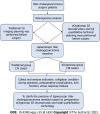Accurate resection of hilar cholangiocarcinoma using eOrganmap 3D reconstruction and full quantization technique
- PMID: 37701684
- PMCID: PMC10494582
- DOI: 10.4240/wjgs.v15.i8.1693
Accurate resection of hilar cholangiocarcinoma using eOrganmap 3D reconstruction and full quantization technique
Abstract
Background: For treatment of hilar cholangiocarcinoma (HCCA), the rate of radical resection is low and prognosis is poor, and preoperative evaluation is not sufficiently accurate. 3D visualization has the advantage of giving a stereoscopic view, which makes accurate resection of HCCA possible.
Aim: To establish precise resection of HCCA based on eOrganmap 3D reconstruction and full quantification technology.
Methods: We retrospectively analyzed the clinical data of 73 patients who underwent HCCA surgery. All patients were assigned to two groups. The traditional group received traditional 2D imaging planning before surgery (n = 35). The eOrganmap group underwent 3D reconstruction and full quantitative technical planning before surgery (n = 38). The preoperative evaluation, anatomical classification of hilar hepatic vessels, indicators associated with surgery, postoperative complications, liver function, and stress response indexes were compared between the groups.
Results: Compared with the traditional group, the amount of intraoperative blood loss in the eOrganmap group was lower, the operating time and postoperative intestinal ventilation time were shorter, and R0 resection rate and lymph node dissection number were higher (P < 0.05). The total complication rate in the eOrganmap group was 21.05% compared with 25.71% in the traditional group (P > 0.05). The levels of total bilirubin, Albumin (ALB) , aspartate transaminase, and alanine transaminase in the eOrganmap group were significantly different from those in the traditional group (intergroup effect: F = 450.400, 79.120, 95.730, and 13.240, respectively; all P < 0.001). Total bilirubin, aspartate transaminase, and alanine transaminase in both groups showed a decreasing trend with time (time effect: F = 30.270, 17.340, and 13.380, respectively; all P < 0.001). There was an interaction between patient group and time (interaction effect: F = 3.072, 2.965, and 2.703, respectively; P = 0.0282, 0.032, and 0.046, respectively); ALB levels in both groups tended to increase with time (time effect: F = 22.490, P < 0.001), and there was an interaction effect between groups and time (interaction effect: F = 4.607, P = 0.004). In the eOrganmap group, there was a high correlation between the actual volume of intraoperative liver specimen resection and the volume of preoperative virtual liver resection (t = 0.916, P < 0.001).
Conclusion: The establishment of accurate laparoscopic resection of hilar cholangiocarcinoma based on preoperative eOrganmap 3D reconstruction and full quantization technology can make laparoscopic resection of hilar cholangiocarcinoma more accurate and safe.
Keywords: 3D reconstruction; Full quantification technology; Hilar cholangiocarcinoma; Laparoscopic surgery; Precise resection; eOrganmap.
©The Author(s) 2023. Published by Baishideng Publishing Group Inc. All rights reserved.
Conflict of interest statement
Conflict-of-interest statement: The authors declare no conflicts of interest for this article.
Figures
Similar articles
-
Comparison of Efficacy and Safety Between Laparoscopic and Open Radical Resection for Hilar Cholangiocarcinoma-A Propensity Score-Matching Analysis.Front Oncol. 2022 Sep 26;12:1004974. doi: 10.3389/fonc.2022.1004974. eCollection 2022. Front Oncol. 2022. PMID: 36226051 Free PMC article.
-
"Hepatic hilum area priority, liver posterior first": An optimized strategy in laparoscopic resection for type III-IV hilar cholangiocarcinoma.World J Gastrointest Surg. 2024 Jul 27;16(7):2167-2174. doi: 10.4240/wjgs.v16.i7.2167. World J Gastrointest Surg. 2024. PMID: 39087123 Free PMC article.
-
Total laparoscopic versus open radical resection for hilar cholangiocarcinoma.Surg Endosc. 2020 Oct;34(10):4382-4387. doi: 10.1007/s00464-019-07211-0. Epub 2019 Oct 29. Surg Endosc. 2020. PMID: 31664578
-
A Consensus Meeting on Expert Recommendations on Operating Specifications for Laparoscopic Radical Resection of Hilar Cholangiocarcinoma.Front Surg. 2021 Nov 23;8:731448. doi: 10.3389/fsurg.2021.731448. eCollection 2021. Front Surg. 2021. PMID: 34888342 Free PMC article.
-
Comparison between liver transplantation and resection for hilar cholangiocarcinoma: A systematic review and meta-analysis.PLoS One. 2019 Jul 31;14(7):e0220527. doi: 10.1371/journal.pone.0220527. eCollection 2019. PLoS One. 2019. PMID: 31365594 Free PMC article.
Cited by
-
Beyond estimates: optimizing surgical strategies through accurate blood loss measurement.Hepatobiliary Surg Nutr. 2025 Jun 1;14(3):464-466. doi: 10.21037/hbsn-2025-75. Epub 2025 May 26. Hepatobiliary Surg Nutr. 2025. PMID: 40529929 Free PMC article. No abstract available.
-
Evaluating the use of three-dimensional reconstruction visualization technology for precise laparoscopic resection in gastroesophageal junction cancer.World J Gastrointest Surg. 2024 May 27;16(5):1311-1319. doi: 10.4240/wjgs.v16.i5.1311. World J Gastrointest Surg. 2024. PMID: 38817296 Free PMC article.
References
-
- Abou-Alfa GK, Macarulla T, Javle MM, Kelley RK, Lubner SJ, Adeva J, Cleary JM, Catenacci DV, Borad MJ, Bridgewater J, Harris WP, Murphy AG, Oh DY, Whisenant J, Lowery MA, Goyal L, Shroff RT, El-Khoueiry AB, Fan B, Wu B, Chamberlain CX, Jiang L, Gliser C, Pandya SS, Valle JW, Zhu AX. Ivosidenib in IDH1-mutant, chemotherapy-refractory cholangiocarcinoma (ClarIDHy): a multicentre, randomised, double-blind, placebo-controlled, phase 3 study. Lancet Oncol. 2020;21:796–807. - PMC - PubMed
-
- Ma D, Wang W, Wang J, Zhang T, Jiang Z, Du G, Yang J, Zhang X, Qin G, Jin B. Laparoscopic versus open surgery for hilar cholangiocarcinoma: a retrospective cohort study on short-term and long-term outcomes. Surg Endosc. 2022;36:3721–3731. - PubMed
-
- Matsuo K, Rocha FG, Ito K, D'Angelica MI, Allen PJ, Fong Y, Dematteo RP, Gonen M, Endo I, Jarnagin WR. The Blumgart preoperative staging system for hilar cholangiocarcinoma: analysis of resectability and outcomes in 380 patients. J Am Coll Surg. 2012;215:343–355. - PubMed
-
- Peng Y, Zhao Z, Zhao Y, Wang Z, Li J, Zhang H, Liu X, Zhou X. Three-dimensional reconstruction of magnetic resonance images of carp brain for brain control technology. J Neurosci Methods. 2022;366:109428. - PubMed
LinkOut - more resources
Full Text Sources
Miscellaneous



